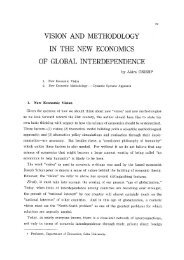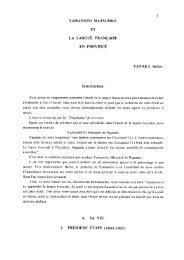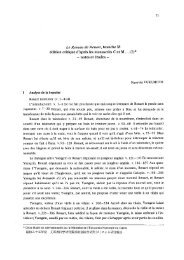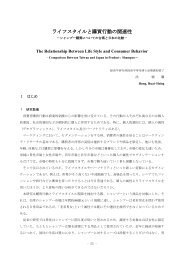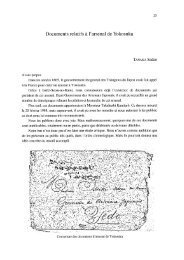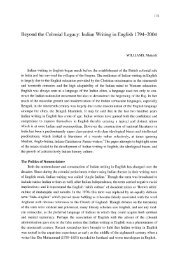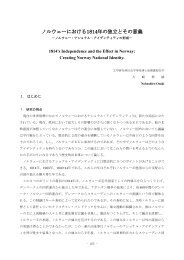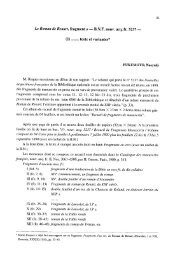New Historicism and Literary Studies - Soka University Repository
New Historicism and Literary Studies - Soka University Repository
New Historicism and Literary Studies - Soka University Repository
Create successful ePaper yourself
Turn your PDF publications into a flip-book with our unique Google optimized e-Paper software.
In Marxism <strong>and</strong> Form, Frederic Jameson explains that the reality of the external world is<br />
largely "interiorized" in discursive forms such as the novel. Storytelling is not something<br />
demeaning but a "coming to self-consciousness of narration."35 But Jameson warns that it is<br />
naive to believe that history "just happens," as do many new historicists. Somehow they fail to<br />
ask questions such as: How <strong>and</strong> why history happens? And who are the people affected by it?36<br />
Althusser's injunction to be wary of ideas in society as they might carry hidden messages of<br />
institutions or bureaucracy ought to be taken seriously.37 Our aim should be to demystify these<br />
ideas <strong>and</strong> expose their construction.<br />
The eagerness with which new historicists connect literature to politics forces Eve<br />
Kosofsky Sedgwich to call new historicist criticism as "good dog/bad dog" criticism where<br />
"progressive" writers are eulogized <strong>and</strong> "reactionary" ones are chastised ."' <strong>New</strong> historicist<br />
practice fails to enter into a more nuanced kind of criticism that accepts dichotomies <strong>and</strong><br />
inherent problems within cultures <strong>and</strong> acknowledges that writers invariably grapple with these<br />
problems in their own unique ways without attempting to or being able to resolve them.<br />
Text <strong>and</strong> Context<br />
In recent years the theory of the text has undergone many changes beyond the confines of<br />
intentional fallacy <strong>and</strong> affective fallacy. Structuralists <strong>and</strong> post-structuralists would have us<br />
believe that the text enjoys autonomy uninfluenced by the intentions of the writer. A critic must<br />
only evaluate the signifiers within the codified structure of the text. Yet intentional theorists see<br />
the text quite the opposite. Quentin Skinner in "Meaning <strong>and</strong> Underst<strong>and</strong>ing in the History of<br />
Ideas," contends that in order to underst<strong>and</strong> a historical text fully, it is necessary to first<br />
underst<strong>and</strong> the intention of the author <strong>and</strong> the context in which the text was written." Paul<br />
Ricoeur points out that a text (or a cultural product such as a poem, novel, play or painting) is<br />
above all a consciously crafted work with an identifiable author (unlike a myth), <strong>and</strong> that<br />
intentionality ought not to be dispensed with in underst<strong>and</strong>ing it.40 Ricoeur introduces the<br />
theory of textual distanciation or the distance text travels from the conditions of its original<br />
production. But Anthony Giddens is quick to point out that distanciation is not a quality of the<br />
text but "a characteristic of social life generally that its products escape the intentional input of<br />
its creators."41 Giddens further argues that a text must also be understood in its context: "To<br />
grasp the meanings of a text as they might have been understood by those who produced it<br />
involves investigating the conditions of their knowledgeability."42 Both Ricoeur <strong>and</strong> Giddens<br />
are effectively supporting three practices—an underst<strong>and</strong>ing of a text beyond a context, an<br />
analysis of a text within a context <strong>and</strong> the study of a text in the making.<br />
Benedict Anderson points out that nation states invariably recognize themselves more<br />
easily through the print forms of the novel <strong>and</strong> the newspaper than scientific or empirical<br />
studies.43 Members of a nation form an imagined community <strong>and</strong> an "image of their<br />
communion" with others, even in diversity through these two media. The novel provides to<br />
them a proxy text representing "the solidity of a single community, embracing characters,<br />
authors <strong>and</strong> readers" negotiating time.44 But this does not mean that the novel is an unmediated<br />
discourse of the nation or national life. The whirligig of taste, taste forming groups, publishers,<br />
critics <strong>and</strong> readers play an equally important role. The novel however attempts to embody or<br />
imagine the sensibility <strong>and</strong> aspirations of the middle class.<br />
127



